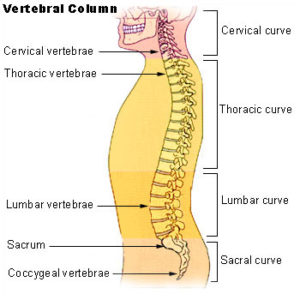In our previous article, we discussed an overview of our bones and what they do (besides the obvious). Now let’s delve a bit deeper to learn what each section of our skeleton does, starting with the spine.
What is the Structure of the Spine?

The spine, also known as the vertebral column is that long curvey bone that we see on posters when we’re in the doctor’s office. It supports our upper body weight. It runs from the base of the skull to the tailbone, also known as the coccyx.
The spine supports our posture but allows us to move while allowing for movement. It also protects the spinal cord.
This column contains 26 bones in adults which include 24 separate vertebrae (interlocking bones that form the spine), but children (adolescent and younger) have 33 bones in the spine because the sacrum (a triangular set of five bones at the base of the spine just above the coccyx) does not fuse with the coccyx until adulthood.

Vertebrae Structure
The vertebrae are divided up into three regions: cervical, thoracic and lumbar and contain several important parts: the body, vertebral foramen, spinous process and transverse process.
There are Five Major Regions of the Spine
-
- Cervical: These are the vertebrae in the neck and form the cervical region of the spine. There are seven of them. They are the thinnest vertebrae in the spine, but they provide great flexibility to the neck area.
- Thoracic: There are 12 vertebrae connected here and are in the chest area, known as the thoracic region. They are larger and stronger than the cervical vertebrae but are not as less flexible as the ones in the neck region.
- Lumbar: You might have heard on commercials about the lumbar. These are five vertebrae in the lower back because there are many people who have issues in this area due to the fact that all of the upper body’s weight puts pressure on this area. These vendors offer cushions that help strengthen the lumbar area. Lumbar vertebrae are stronger than the thoracic vertebrae, but not strong enough to cause some people periodic pain.
- Sacral: The sacrum is a single bone in the adult skeleton that is formed by the fusion of the five smaller vertebrae when adulthood starts.
- Coccygeal: As the name suggests, this is where the coccyx resides. It is a single bone in the adult skeleton and is formed by the fusion of four vertebrae at the beginning of adulthood. Also known as the tailbone, it holds our body weight when we sit.
The Spine Numbering System

The spine is numbered by its the first letter of their vertebrae regions; accordingly, there are five categories of designation.
At the top of the vertical column are the seven cervical spinal nerves labeled C1 through C8. Then there are the 12 thoracic nerves, which are labeled T1 through T12.
Similarly, there are the 5 lumbar spinal nerves titled L1 through L5 and under the lumbar are the 5 sacral spinal nerves S1 through S5 and then the coccygeal of which there is 1.
What Are Some Diseases Associated with the Spine?
Otherwise known as back pain, there are many illnesses associated with the spine. There is Kyphosis, an abnormally excessive curvature of the spine and happens when the vertebrae in the upper back area become more wedge-shaped.
There also herniated disks. Known as the vertebral discs they have the function of shock absorption. With this disc becomes ruptured, it becomes smaller and is no longer able to provide as the amount of shock absorption is was initially intended for. This can result in back pain, sciatica and other disorders. Herniated discs can be caused by injury or from the normal wear and tear of aging. Treatment can be by medication and/or physical therapy and if these methods do not work, then surgery might be needed.
For a comprehensive list of spine disorders, please click here.

